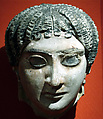Mask of a woman with radiating waves of hair
Roman Period
The plaster masks derive from pharaonic traditions, in which the mask served as a substitute for the head of the deceased and as a means of elevating him or her to immortal status. The derivation is often reflected in paintings and texts located on the mantle surrounding the head.
Like the painted mummy portraits, the masks suggest strongly individualized appearances and affect Roman fashions in hairstyle, jewelry, and dress. They follow, however, a somewhat different pattern. For example, female masks may have coiffures that combine Roman arrangements of the upper part of the hair with long corkscrew locks that were considered typically Egyptian.
Despite the seeming individuality of the masks, most faces were made in a mold. Distinguishing details were worked in the plaster with a spatula or knife. The ears were added separately, and sometimes eyes were inlaid with glass or stone. The mask was then frequently painted or gilded.
This woman's eyes were inlaid over painted pupils with transparent glass, now somewhat degraded. Faint traces of rose-pink are visible on her lips. At the crown the knot of hair has a hole where an actual hairpin of metal, or perhaps ivory, could have been inserted. Traces of drop earrings remain.
Due to rights restrictions, this image cannot be enlarged, viewed at full screen, or downloaded.

